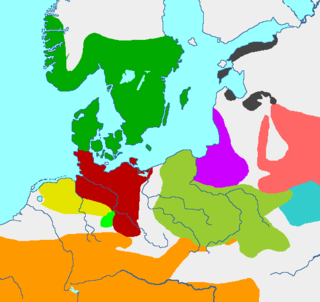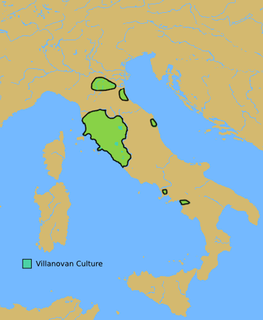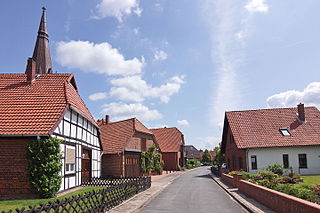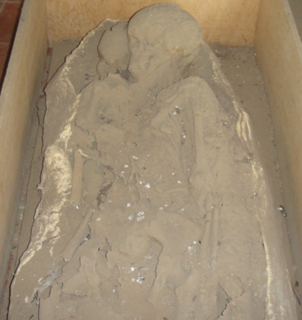
Hydriotaphia, Urn Burial, or, a Discourse of the Sepulchral Urns lately found in Norfolk is a work by Sir Thomas Browne, published in 1658 as the first part of a two-part work that concludes with The Garden of Cyrus.

A columbarium is a structure for the reverential and usually public storage of funerary urns, holding cremated remains of the deceased.

Yomp is Royal Marines slang describing a long-distance loaded march carrying full kit. It was popularised by journalistic coverage in 1982 during the Falklands War. The origin of the word is unclear, and there is no evidence to suggest that it derives originally from an acronym. Various backronymic definitions have however been proposed, including “young officers marching pace”, "your own marching pace" and a connection with the term yump used in rally-driving in the sense of "to leave the ground when taking a crest at speed", apparently a Scandinavian pronunciation of jump.

The Lusatian culture existed in the later Bronze Age and early Iron Age in most of what is now Poland and parts of the Czech Republic, Slovakia, eastern Germany and western Ukraine. It covers the Periods Montelius III to V of the Northern European chronological scheme.

The Pomeranian culture, also Pomeranian or Pomerelian Face Urn culture was an Iron Age culture with origins in parts of the area south of the Baltic Sea, from the 7th century BC to the 3rd century BC, which eventually covered most of today's Poland.

Richard Westall was an English painter and illustrator of portraits, historical and literary events, best known for his portraits of Byron. He was also Queen Victoria's drawing master.

An urn is a vase, often with a cover, with a typically narrowed neck above a rounded body and a footed pedestal. Describing a vessel as an "urn", as opposed to a vase or other terms, generally reflects its use rather than any particular shape or origin. The term is especially often used for funerary urns, vessels used in burials, either to hold the cremated ashes or as grave goods, but is used in many other contexts. In catering, large vessels for serving tea or coffee are often called "tea-urns", even when they are metal cylinders of purely functional design. Large sculpted vases are often called urns, whether placed outdoors, in gardens or as architectural ornaments on buildings, or kept inside. Urns are also a common reference in thought experiments in probability wherein marbles or balls of different colors are used to represent different results and the urn represents the "container" of the whole set of possible states.
William Bury Westall was an English novelist born in Old Accrington, Lancashire, England.

The Villanovan culture, regarded as the earliest phase of the Etruscan civilization, was the earliest Iron Age culture of Italy. It directly followed the Bronze Age Proto-Villanovan culture which branched off from the Urnfield culture of Central Europe. The name derives from the locality of Villanova, a fraction of the municipality of Castenaso in the Metropolitan City of Bologna where, between 1853 and 1855, Giovanni Gozzadini found the remains of a necropolis, bringing to light 193 tombs, of which there were 179 cremations and 14 inhumations.
Robert Atkinson Westall was an English author and teacher known for fiction aimed at children and young people. Some of the latter cover complex, dark, and adult themes. He has been called "the dean of British war novelists". His first book, The Machine Gunners, won the 1975 Carnegie Medal for the year's outstanding children's book by a British subject. It was named among the top ten Medal-winners at the 70th anniversary celebration in 2007. Westall also won a second Carnegie, a Smarties Prize, and the once-in-a-lifetime Guardian Prize.

Notaresco is a town and comune in the Teramo province in the Abruzzo region of eastern central Italy. It has population of just under 3000. The patron saint of Notaresco is San Gennaro.

The Shergotty meteorite is the first example of the shergottite Martian meteorite family. It was a 5-kilogram (11 lb) meteorite which fell to Earth at Sherghati, in the Gaya district, Bihar, India on 25 August 1865, and was retrieved by witnesses almost immediately. Radiometric dating indicates that it solidified from a volcanic magma about 4.1 billion years ago. It is composed mostly of pyroxene and is thought to have undergone preterrestrial aqueous alteration for several centuries. Certain features within its interior are suggestive of being remnants of biofilm and their associated microbial communities.

The Westall UFO was a reported UFO sighting in Australia that occurred on 6 April 1966 in Melbourne, Victoria.

Leese is a municipality in the district of Nienburg, in Lower Saxony, Germany.

Lavau is a commune in the Aube department in north-central France in the Grand Est Region. It is situated on the banks of the river Seine
Wilfrid Arthur Edmund Westall was an English Anglican bishop in the 20th century. He served as Archdeacon of Exeter and as Bishop of Crediton.

Romulus and Remus is a painting by the Flemish artist Peter Paul Rubens. It is housed in the Pinacoteca Capitolina in Rome, Italy. It depicts the brothers Romulus and Remus being cared for by a wolf. The painting also shows the god of the Tiber river sitting on his urn, a woodpecker that watched over the twins to bring them food, and a shepherd discovering the infants.

Los Placeres is an archeological site located between the “Waspán” and “Tabacalera Nicaragüense” neighborhoods at kilometer 4½ of the “Carretera Norte”, in Managua, en Nicaragua. The site extends to the coast of Lake Managua. A large part of the area that delimits the site is being impacted by a new urban settlement known as Barrio Hugo Chávez, which divides the site, where its new settlers have disturbed the ground for installation of pipes for drinking water, toilet and housing, this activity has caused a serious incidental findings and impacts to the prehispanic archaeological site.

Neugebäude Palace is a large Mannerist castle complex in the Simmering district of Vienna, Austria. It was built from 1569 onwards, at the behest of the Habsburg emperor Maximilian II. The site of the palace is said to be where the Ottoman Sultan Süleyman the Magnificent's tent was erected during the 1529 Siege of Vienna. The palace was apparently modeled after it.
Burial in Early Anglo-Saxon England refers to the grave and burial customs followed by the Anglo-Saxons between the mid 5th and 11th centuries CE in Early Mediaeval England. The variation of the practice performed by the Anglo-Saxon peoples during this period, included the use of both cremation and inhumation. There is a commonality in the burial places between the rich and poor - their resting places sit alongside one another in shared cemeteries. Both of these forms of burial were typically accompanied by grave goods, which included food, jewelry, and weaponry. The actual burials themselves, whether of cremated or inhumed remains, were placed in a variety of sites, including in cemeteries, burial mounds or, more rarely, in ship burials.
















